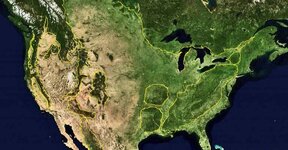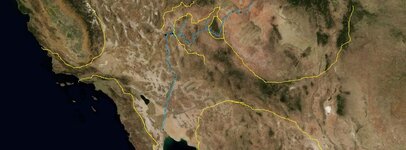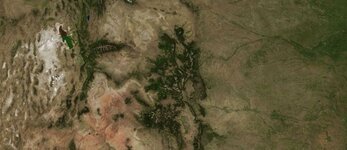EE THr
Silver Member
Y'know, in thinking about this, and trying to visualize the ridge springing a leak, and more and more water causing the opening to get bigger, faster and faster; I can understand a large water flow resulting from that, causing a very wide water path, like the widest parts of the Grand Canyon at the top.
But what kind of pattern would it make as the water gradually emptied out of the inland sea?
I could understand the water flow increasing in stages, rather than evenly, from large chunks of the ridge falling away. And those flow stages affecting the erosion in stages, from low flow for awhile, then jumping to a higher flow rate for awhile, and on and on. But would that create the steps in the layers, like they are? I would think that the flow becoming greater, would wipe out the beginning narrow channel, and just create one big channel, no?
Plus, the beginning narrow channel wouldn't be at the bottom, it would be at the top surface, because it would have been the first cut. So, why would the narrower pattern "work it's way downward" in the same proportion, or relative width and depth? I don't think it would. I think the later larger flow would just carve out a "bigger ditch" altogether, with no differences such as the "step layers."
However, many old rivers and creeks have "high banks" that are much wider than the current banks. This is because the water flow has decreased. So this looks very much like how the Grand Canyon got the steps. That is, by flows decreasing, but in stages.
Like I said, I can see the flow increasing in stages, but what would make it decrease in stages? I think that once the big hole is "blown" in the ridge, nothing will make the water flow decrease, except the inland sea running out of water.
When the inland sea was full, the flow would be the most, and as it emptied, the flow rate would decrease because of less water pressure behind it, right? So, it would decrease gradually and evenly. But not in steps.
Therefore, if the steps aren't a result of the beginning part of the flow, and they aren't the result of the decrease of the flow, then it's impossible for them to be there.
But they are there, so I think there must have been something else at work, in order to time the release of water, to be able to have the steps which are there now.
That would be either seasonal cycles, or some other type of, possibly even longer, cycles.

But what kind of pattern would it make as the water gradually emptied out of the inland sea?
I could understand the water flow increasing in stages, rather than evenly, from large chunks of the ridge falling away. And those flow stages affecting the erosion in stages, from low flow for awhile, then jumping to a higher flow rate for awhile, and on and on. But would that create the steps in the layers, like they are? I would think that the flow becoming greater, would wipe out the beginning narrow channel, and just create one big channel, no?
Plus, the beginning narrow channel wouldn't be at the bottom, it would be at the top surface, because it would have been the first cut. So, why would the narrower pattern "work it's way downward" in the same proportion, or relative width and depth? I don't think it would. I think the later larger flow would just carve out a "bigger ditch" altogether, with no differences such as the "step layers."
However, many old rivers and creeks have "high banks" that are much wider than the current banks. This is because the water flow has decreased. So this looks very much like how the Grand Canyon got the steps. That is, by flows decreasing, but in stages.
Like I said, I can see the flow increasing in stages, but what would make it decrease in stages? I think that once the big hole is "blown" in the ridge, nothing will make the water flow decrease, except the inland sea running out of water.
When the inland sea was full, the flow would be the most, and as it emptied, the flow rate would decrease because of less water pressure behind it, right? So, it would decrease gradually and evenly. But not in steps.
Therefore, if the steps aren't a result of the beginning part of the flow, and they aren't the result of the decrease of the flow, then it's impossible for them to be there.
But they are there, so I think there must have been something else at work, in order to time the release of water, to be able to have the steps which are there now.
That would be either seasonal cycles, or some other type of, possibly even longer, cycles.






 Yeah, and glaciers don't melt THAT fast. Actually, no were near fast enough to produce the kind of water flow as produced these flood plains.
Yeah, and glaciers don't melt THAT fast. Actually, no were near fast enough to produce the kind of water flow as produced these flood plains.


